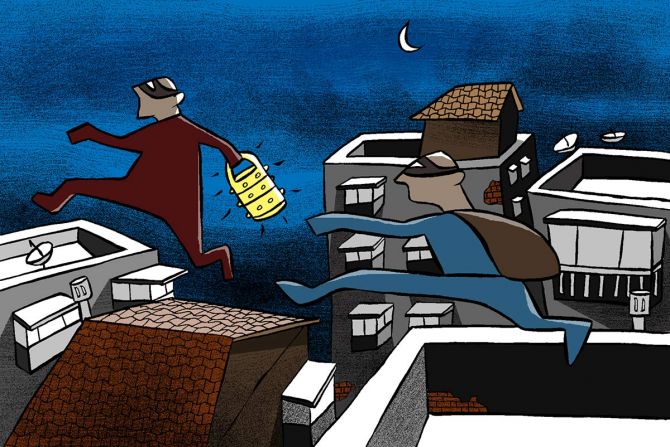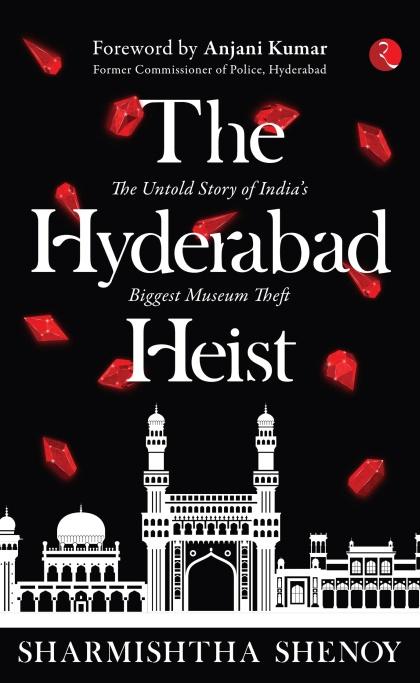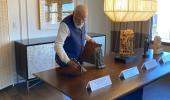The Hyderabad Heist is a blow-by-blow account of an audacious theft committed in 2018, and a recounting of how the Hyderabad police combined technology and human intelligence to crack the case

'Criminals who steal high-value artworks tend to be better thieves than businessmen. They don't understand that the true art in a heist isn't stealing, it's selling.'
This is the Federal Bureau of Investigation's view on museum thefts, Anjani Kumar, then police commissioner of Hyderabad, tells his team in the early chapters of The Hyderabad Heist.
The agent he is quoting is Robert Wittman, founder of the FBI's National Art Crime Team, who has said this in more than one interview.
The fact that stealing such treasures is easier than selling them is a major reason a small percentage of stolen art and artefacts of note is recovered across the world.
Given this, what were the chances of recovering the treasures stolen from the Nizam's Museum in Hyderabad? Turns out the case was solved in 10 days flat and Rs 50 crore (Rs 500 million) worth of antique artefacts reclaimed.
These historical items, gifted from across the world to the Nizam of Hyderabad on his golden jubilee in 1937, included a gold tiffin box studded with diamonds; a gold cup and saucer set studded with emeralds and rubies; and a gold spoon with a single emerald embedded in its handle.
The Hyderabad Heist is a blow-by-blow account of this audacious theft committed in the small hours of September 3, 2018 and a recounting of how the Hyderabad Police combined technology and human intelligence to crack the case.
The book reads like a classic chor-police potboiler that plays out in the old city of Hyderabad and Mumbai's Zaveri Bazaar where the thieves make their futile attempts to sell the antiques.
That two petty thieves -- one a bully who has earned the name of Khooni Badshah and the other called Ghulam, relatively more intelligent and more cautious of the two -- could pull off such a feat with such ease is a comment on how casually we treat the security and upkeep of objects of historical and cultural value.
These were small items that the thieves, both habitual offenders, could slip into a duffle bag.
India is a country where even protected monuments go 'missing' -- so much so that the Archaeological Survey of India has decided to form a special committee to trace 24 such 'missing' monuments.
Through the eyes of the investigators, the book draws attention to the many slips and violations that made it a theft waiting to happen.
One, the cash-strapped privately funded museum could only afford bare basic security.
To the extent that when a CCTV camera stopped functioning, it took 10 days to get it fixed. And this is no ordinary museum.
It's the museum of the seventh and last Nizam of Hyderabad, Osman Ali Khan -- back then the richest man on the planet who headed the largest princely state in British India.
His net worth was estimated at over $230 billion after adjusting for inflation, the book mentions, which was almost as much as the net worth of Elon Musk ($286 billion) in 2022.
The museum had on public display some 400 of his treasures. The curator hoped the government would take over its upkeep.
Two, there were several illegal private buildings abutting the museum that made it possible for the thieves to jump from terrace to terrace and make good their escape.
Three, the guard who was supposed to clean the room where the artefacts were kept played truant that day. So, the theft was discovered only when the museum opened to visitors.
It was a young couple, one of them a vlogger, who noticed the open, empty showcases and alerted the staff.
It is through this vlogger and the lazy guard, whose father was the Nizam's khansama (cook), that some historical insights are offered.
For instance, how the various wings of the Nizam's palace are set, the family's history, the sixth Nizam's flamboyant lifestyle and the miserly ways of his billionaire heir.

The world's richest man would even smoke cigarette butts left behind by visitors and though he owned a 100-piece dinner set of solid gold, he ate his frugal meals off a tin plate.
Incidentally, the two thieves ate twice out of his three-tiered gold tiffin.
As the book captures the police operation, sometimes guided and often misguided by its network of informers, it also lists the many tools the investigators deployed: A C-Dart app to analyse the cell tower data; a TSCOP app for the list of offenders; and the Jail Release Monitor System to track which crook was out of prison at the time of the theft.
While the story of the heist needed to be told, the writing is loose, often cliched, and the author mostly sticks to first names -- the curator is Kalam; the administrative officer is Bilal; the guard is Farhan; most police officers are also similarly identified.
The book also has some factual errors. For instance, in the list of unsolved museum cases, author Sharmishtha Shenoy mentions Munch's The Scream and The Madonna stolen from Oslo's Munch Museum in August 2004. These works were recovered in August 2006.
It also mentions two Van Gogh paintings stolen from the Van Gogh Museum in Amsterdam in 2002. These, too, were recovered from Italy in September 2016.
In the Gardner Museum theft case, Ms Shenoy writes 12 paintings were stolen, whereas the correct number is 13.
One of the world's biggest art heists, the Gardner Museum theft has also inspired a Netflix documentary. Small details such as these can make a book go from okay to great.
The Hyderabad Heist: The Untold Story of India's Biggest Museum Theft
Author: Sharmishtha Shenoy
Publisher: Rupa
Pages: 199
Price: Rs 395
Feature Presentation: Rajesh Alva/Rediff.com











